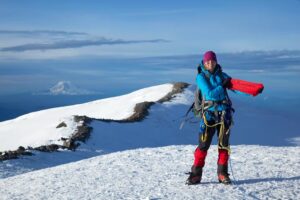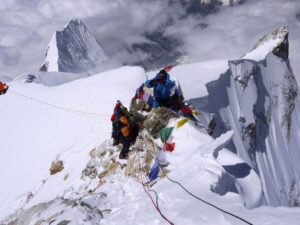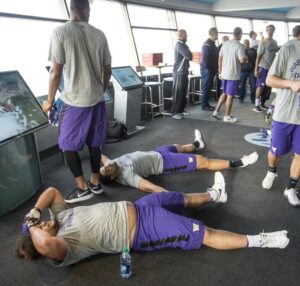 Seattle’s iconic Space Needle has 832 stairs. If you climb 831 of them, then go down, did you climb the Space Needle? I say NO! you have to climb it again (sign up here), and go all the way to the top, to say you climbed it. Unfair? Life isn’t fair.
Seattle’s iconic Space Needle has 832 stairs. If you climb 831 of them, then go down, did you climb the Space Needle? I say NO! you have to climb it again (sign up here), and go all the way to the top, to say you climbed it. Unfair? Life isn’t fair.
Photo at left: Members of the University of Washington’s 2016 football team after summiting the Space Needle
Same deal with Mt. Rainier. The gal in the photo below clearly isn’t on the summit. Her flag, which says “Mt. Rainier, 14,409′,” even admits it; the summit is 14,411′ or 14,417′, depending on which elevation in Wikipedia (here) you accept, or maybe it’s something else. And it’s obvious that, while her head is sticking up above the highest point, she’s not standing on it.
Photo below: This woman is NOT on Mt. Rainier’s summit (text continues below)
There’s probably a lot of deliberate cheating on the world’s highest mountains, too. For example, in the photo below, these climbers are NOT standing on the 26,781′ summit of Manaslu. That includes the guy in the blue jacket. The summit is one of those other points (I’m not sure which one). But looking at them, and they look about equally scary, who wants to risk the last 60 feet just to gain another 3 feet of elevation?
Photo below: These climbers are NOT on Manaslu’s summit (text continues below)
It’s not always the climbers’ fault they didn’t climb all the way to the summit. It can be hard to figure out just where it is, especially if the summit is socked in, or you reach it in the dark, or you’re exhausted and snow-blind and suffering from hypoxia. And the terrain itself can be very confusing. For example, Annapurna has a long summit ridge that looks more or less level.
Photo below: This climber is at Annapurna’s 26,545′ true summit, because he did the homework and figured out where it is; but he isn’t standing on it, and there are no footprints on the highest spot, so he did NOT climb the mountain (text continues below)
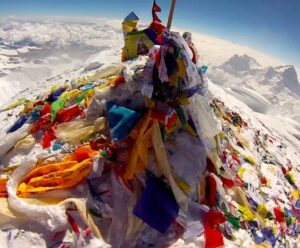 In 2020, the American Alpine Journal published an article (read it here) about a study of summit claims that concluded many climbers called it quits short of the summit, kind of like climbing only 831 of the Space Needle’s 832 steps, and then claim they climbed the mountain.
In 2020, the American Alpine Journal published an article (read it here) about a study of summit claims that concluded many climbers called it quits short of the summit, kind of like climbing only 831 of the Space Needle’s 832 steps, and then claim they climbed the mountain.
This doesn’t happen as often on Everest, which has an unambiguous summit, and comes up most frequently in connection with mountains like Annapurna that have ambiguous or hard to define summits.
Photo at right: Everest’s summit is relatively easy to identify compared to some peaks
But they also note, “Many of these non-summits occurred in recent years during the boom in commercial guiding of 8,000-meter peaks,” and why should tourists get credit for summiting an 8,163-meter mountain if they climbed only 8,162 meters of it?
One of mountaineering’s enduring mysteries is whether Mallory and Irvine summited Everest in 1924, thus beating Hillary and Tenzing by 29 years, and doing it by the old North Col route, which as far as we know was first climbed in entirety by the Chinese in 1960. I’ll lay odds they didn’t. Mallory’s body was found in 1998, but Irvine (and the camera he supposedly was carrying) is still missing (although there are unverified rumors the Chinese recovered his body at some point).
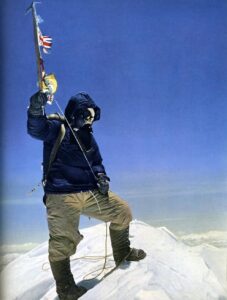 Even if they overcame the Second Step, which several expert climbers who’ve been there consider unlikely, and continued past the Third Step, which isn’t difficult, and on up the final snow slope, I’ll bet the photos would show they were not on the summit. For that matter, it’s not altogether clear who did climb Everest first, if anybody ever did, as Hillary and Tenzing plainly didn’t.
Even if they overcame the Second Step, which several expert climbers who’ve been there consider unlikely, and continued past the Third Step, which isn’t difficult, and on up the final snow slope, I’ll bet the photos would show they were not on the summit. For that matter, it’s not altogether clear who did climb Everest first, if anybody ever did, as Hillary and Tenzing plainly didn’t.
Photo at left: In Hillary’s famous photo on May 29, 1953, the summit is behind Tenzing’s left knee, and there are no footprints visible on it, so Hillary — who later claimed he got there ahead of Tenzing — didn’t stand on it either
Video below: This climber is NOT on the Matterhorn’s summit; “one of the highest points” doesn’t count
